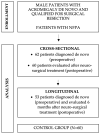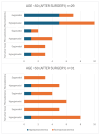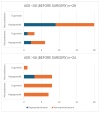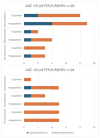Every Third Male Patient with Acromegaly Recovers from Hypogonadism after Neurosurgical Treatment
- PMID: 39337013
- PMCID: PMC11432164
- DOI: 10.3390/jcm13185526
Every Third Male Patient with Acromegaly Recovers from Hypogonadism after Neurosurgical Treatment
Abstract
Background: Acromegaly is a rare endocrine condition caused by excessive growth hormone (GH) production. Hypogonadotropic hypogonadism (HH) affects 30%-50% of acromegaly patients. Objectives: This study examined the frequency of HH in men with acromegaly and the effects of neurosurgical treatment during the follow-up period. Materials and Methods: A retrospective analysis of medical records from January 2015 to December 2022 was conducted. Data included clinical history, laboratory results, and pituitary MRI findings. Statistical analysis was performed using Statistica 13.3. Results: Patients were divided into two groups: a cross-sectional sample (preoperative n = 62; postoperative n = 60) and a longitudinal sample (n = 53). In the longitudinal sample, preoperative HH was diagnosed in 41 males (77.36%). Post-surgery, HH prevalence decreased to 58.49% (n = 31), with a significant increase in postoperative testosterone levels (9.1 vs. 12.1 nmol/L; p < 0.001), particularly in patients with preoperative HH (7.2 vs. 10.2 nmol/L; p < 0.001). Among 41 patients with HH, 12 (29.27%) showed recovery. Testosterone levels were lower in patients with macroadenomas (7.2 nmol/L vs. 11.05 nmol/L; p < 0.001). Patients with HH had higher baseline levels of GH and insulin-like growth factor 1 (IGF-1) (GH: 3.37 ng/mL; IGF-1: 551 ng/mL vs. GH: 1.36 ng/mL; IGF-1: 355 ng/mL). Luteinizing hormone (LH) levels above 3.3 mIU/mL and follicle-stimulating hormone (FSH) levels above 4.4 mIU/mL predicted hypogonadism remission (Area under the curve (AUC): 0.838 and 0.792, respectively). Conclusions: Younger patients with macroadenoma and hyperprolactinemia are more likely to have preoperative hypogonadism. Neurosurgical treatment can normalize LH, FSH, and total testosterone in approximately 30% of these patients.
Keywords: GH; acromegaly; hypogonadotropic hypogonadism; pituitary adenoma; pituitary tumor; testosterone.
Conflict of interest statement
The authors declare no conflicts of interest.
Figures






Similar articles
-
PITUITARY IMAGING BY MRI AND ITS CORRELATION WITH BIOCHEMICAL PARAMETERS IN THE EVALUATION OF MEN WITH HYPOGONADOTROPIC HYPOGONADISM.Endocr Pract. 2019 Sep;25(9):926-934. doi: 10.4158/EP-2018-0609. Epub 2019 Jun 6. Endocr Pract. 2019. PMID: 31170366
-
GH-induced LH hyporesponsiveness as a potential mechanism for hypogonadism in male patients with acromegaly.Endocr J. 2021 Aug 28;68(8):953-968. doi: 10.1507/endocrj.EJ20-0596. Epub 2021 Apr 9. Endocr J. 2021. PMID: 33840669
-
[The differential diagnosis of constitutional delay of puberty and hypogonadotropic hypogonadism in boys].Probl Endokrinol (Mosk). 2020 Jun 10;65(6):417-424. doi: 10.14341/probl10339. Probl Endokrinol (Mosk). 2020. PMID: 33351324 Russian.
-
Reoperation for growth hormone-secreting pituitary adenomas: report on an endonasal endoscopic series with a systematic review and meta-analysis of the literature.J Neurosurg. 2018 Aug;129(2):404-416. doi: 10.3171/2017.2.JNS162673. Epub 2017 Sep 1. J Neurosurg. 2018. PMID: 28862548
-
Treatment of acromegaly by endoscopic transsphenoidal surgery: surgical experience in 214 cases and cure rates according to current consensus criteria.J Neurosurg. 2013 Dec;119(6):1467-77. doi: 10.3171/2013.8.JNS13224. Epub 2013 Sep 27. J Neurosurg. 2013. PMID: 24074496 Review.
References
LinkOut - more resources
Full Text Sources
Miscellaneous

